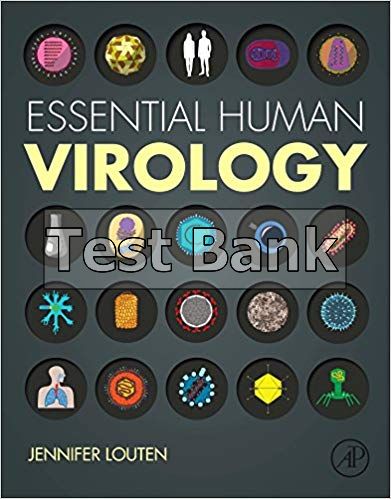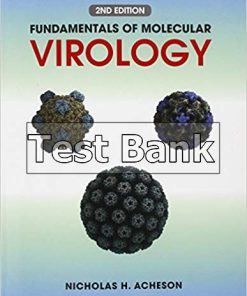Essential Human Virology 1st Edition Louten Test Bank
$50.00 Original price was: $50.00.$26.50Current price is: $26.50.
Essential Human Virology 1st Edition Louten Test Bank.
Essential Human Virology 1st Edition Louten Test Bank

Product details:
- ISBN-10 : 0128009470
- ISBN-13 : 978-0128009475
- Author: Jennifer Louten
Essential Human Virology is written for the undergraduate level with case studies integrated into each chapter. The structure and classification of viruses will be covered, as well as virus transmission and virus replication strategies based upon type of viral nucleic acid. Several chapters will focus on notable and recognizable viruses and the diseases caused by them, including influenza, HIV, hepatitis viruses, poliovirus, herpesviruses, and emerging and dangerous viruses.
Additionally, how viruses cause disease, or pathogenesis, will be highlighted during the discussion of each virus family, and a chapter on the immune response to viruses will be included. Further, research laboratory assays and viral diagnosis assays will be discussed, as will vaccines, anti-viral drugs, gene therapy, and the beneficial uses of viruses. By focusing on general virology principles, current and future technologies, familiar human viruses, and the effects of these viruses on humans, this textbook will provide a solid foundation in virology while keeping the interest of undergraduate students.
Table contents:
- Chapter 1. The World of Viruses
- 1.1. The Importance of Studying Viruses
- 1.2. Viruses Are Not Alive
- 1.3. The Origin of Viruses
- 1.4. The Discovery of Viruses
- 1.5. Other Nonliving Infectious Agents
- Summary of Key Concepts
- Flash Card Vocabulary
- Chapter Review Questions
- Chapter 2. Virus Structure and Classification
- 2.1. Common Characteristics of Viruses
- 2.2. Structure of Viruses
- 2.3. Virus Classification and Taxonomy
- Summary of Key Concepts
- Flash Card Vocabulary
- Chapter Review Questions
- Chapter 3. Features of Host Cells: Cellular and Molecular Biology Review
- 3.1. The Basic Organization of the Cell
- 3.2. The Plasma Membrane, Exocytosis, and Endocytosis
- 3.3. The Cell Cycle
- 3.4. The Central Dogma of Molecular Biology: DNA Replication
- 3.5. The Central Dogma of Molecular Biology: RNA Transcription and Processing
- 3.6. The Genetic Code
- 3.7. The Central Dogma of Molecular Biology: Protein Translation
- 3.8. Promotion of Viral Transcription and Translation Processes
- Summary of Key Concepts
- Flash Card Vocabulary
- Chapter Review Questions
- Chapter 4. Virus Replication
- 4.1. Attachment
- 4.2. Penetration
- 4.3. Uncoating
- 4.4. Replication
- 4.5. Assembly
- 4.6. Maturation
- 4.7. Release
- 4.8. Virus Growth Curves
- Summary of Key Concepts
- Flash Card Vocabulary
- Chapter Review Questions
- Chapter 5. Virus Transmission and Epidemiology
- 5.1. Portals of Virus Entry
- 5.2. Dissemination Within a Host
- 5.3. Portals of Virus Exit
- 5.4. Patterns of Infection
- 5.5. Epidemiology
- 5.6. Epidemiological Studies
- Summary of Key Concepts
- Flash Card Vocabulary
- Chapter Review Questions
- Chapter 6. The Immune Response to Viruses
- 6.1. The Innate Immune System
- 6.2. The Adaptive Immune System
- 6.3. Viral Evasion of the Immune Response
- Summary of Key Concepts
- Flash Card Vocabulary
- Chapter Review Questions
- Chapter 7. Detection and Diagnosis of Viral Infections
- 7.1. Collection and Transport of Clinical Specimens
- 7.2. Virus Culture and Cell/Tissue Specimens
- 7.3. Detection of Viral Antigens or Antiviral Antibodies
- 7.4. Detection of Viral Nucleic Acids
- Summary of Key Concepts
- Flash Card Vocabulary
- Chapter Review Questions
- Chapter 8. Vaccines, Antivirals, and the Beneficial Uses of Viruses
- 8.1. Vaccine Development
- 8.2. Antivirals
- 8.3. The Beneficial Uses of Viruses
- Summary of Key Concepts
- Flash Card Vocabulary
- Chapter Review Questions
- Chapter 9. Viruses and Cancer
- 9.1. Properties of Cancerous Cells
- 9.2. Control of the Cell Cycle
- 9.3. Important Genes Involved in the Development of Cancer
- 9.4. Oncogenic Viruses
- Summary of Key Concepts
- Flash Card Vocabulary
- Chapter Review Questions
- Chapter 10. Influenza Viruses
- 10.1. Influenza Taxonomy and Types
- 10.2. Clinical Course of Infection
- 10.3. Molecular Virology
- 10.4. Genetic Changes in the Influenza Genome
- 10.5. Historical Influenza Antigenic Shifts
- 10.6. Highly Pathogenic Avian Influenza
- Summary of Key Concepts
- Flash Card Vocabulary
- Chapter Review Questions
- Chapter 11. Human Immunodeficiency Virus
- 11.1. History of HIV Infection
- 11.2. Taxonomy and Origins of HIV
- 11.3. Epidemiology of HIV/AIDS
- 11.4. Clinical Progression of HIV/AIDS
- 11.5. Molecular Virology and Replication of HIV-1
- Summary of Key Concepts
- Flash Card Vocabulary
- Chapter Review Questions
- Chapter 12. Hepatitis Viruses
- 12.1. Clinical Course of Hepatitis Virus Infections
- 12.2. Transmission and Epidemiology of Hepatitis Viruses
- 12.3. Molecular Virology of the Hepatitis Viruses
- Summary of Key Concepts
- Flash Card Vocabulary
- Chapter Review Questions
- Chapter 13. Herpesviruses
- 13.1. Herpesvirus Classification
- 13.2. Clinical Conditions Caused by Herpesviruses
- 13.3. Molecular Virology
- 13.4. Latency
- Summary of Key Concepts
- Flash Card Vocabulary
- Chapter Review Questions
- Chapter 14. Poliovirus
- 14.1. The Early Years of Poliovirus
- 14.2. Clinical Course of Infection
- 14.3. Poliovirus Replication
- 14.4. Epidemiology and Worldwide Eradication Efforts
- Summary of Key Concepts
- Flash Card Vocabulary
- Chapter Review Questions
- Chapter 15. Poxviruses
- 15.1. Taxonomy
- 15.2. Clinical Course of Variola Infection
- 15.3. Poxvirus Replication Cycle
- 15.4. Eradication of Smallpox
- Summary of Key Concepts
- Flash Card Vocabulary
- Chapter Review Questions
- Chapter 16. Emerging and Reemerging Viral Diseases
- 16.1. Factors Involved in the Emergence of Viral Infectious Diseases
- 16.2. Notable Emerging/Reemerging Viral Diseases
- Summary of Key Concepts
- Flash Card Vocabulary
- Chapter Review Questions
- Appendix 1
- Appendix 2
- Index
Instant download after Payment is complete
You may also like…
Solutions Manual
Solutions Manual
Fundamentals of Molecular Virology 2nd Edition Acheson Test Bank
Solutions Manual




















